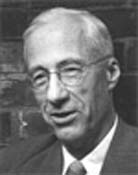 Joel Henry Hildebrand (November 16, 1881 – April 30, 1983) was an American educator and a pioneer chemist. He was a major figure in chemistry research specializing in liquids and nonelectrolyte solutions.
Joel Henry Hildebrand (November 16, 1881 – April 30, 1983) was an American educator and a pioneer chemist. He was a major figure in chemistry research specializing in liquids and nonelectrolyte solutions.
Hildebrand graduated from the University of Pennsylvania in 1903. He served briefly in the faculty before going to the University of California, Berkeley as a chemistry instructor in 1913. He served as the Dean of the College of Chemistry from 1949 through 1951. He retired from full time teaching in 1952 but remained a University Professor at Berkeley until his death.
His 1924 monograph on the solubility of non-electrolytes, Solubility, was the classic reference for almost half a century. In 1927, Hildebrand coined the term "regular solution" (to be contrasted with "ideal solution") and discussed their thermodynamic aspects in 1929. Hildebrand's many scientific papers and chemistry texts include "An Introduction to Molecular Kinetic Theory" (1963) and "Viscosity and Diffusivity" (1977). He received the Distinguished Service Medal in 1918 and the King's Medal (British) in 1948.
Hildebrand served on the Council of the National Academy of Sciences and was also a member of the Citizens Advisory Committee on Education to the California Legislature. He made several discoveries of which the most notable was the introduction in the mid-1920s of helium and oxygen breathing mixtures to replace air for divers to alleviate the condition known as the bends. This discovery was later used to save the lives of 33 members of the submarine USS Squalus which went down in 1939.
Hildebrand won virtually every major prize in the field of chemistry except the Nobel Prize. The American Chemical Society created the Joel Henry Hildebrand Award in his honor for work pertaining to the field of theoretical and experimental chemistry of liquids. The first award was presented to Hildebrand himself in 1981 as part of the observances of his 100th birthday.
Professor Hildebrand often said he most cherished his role as a teacher. In an interview conducted shortly before his 100th birthday, he observed: "Good teaching is primarily an art, and can neither be defined or standardized ... Good teachers are born and made; neither part of the process can be omitted." He remained committed to working with undergraduate students even at the age of 100.